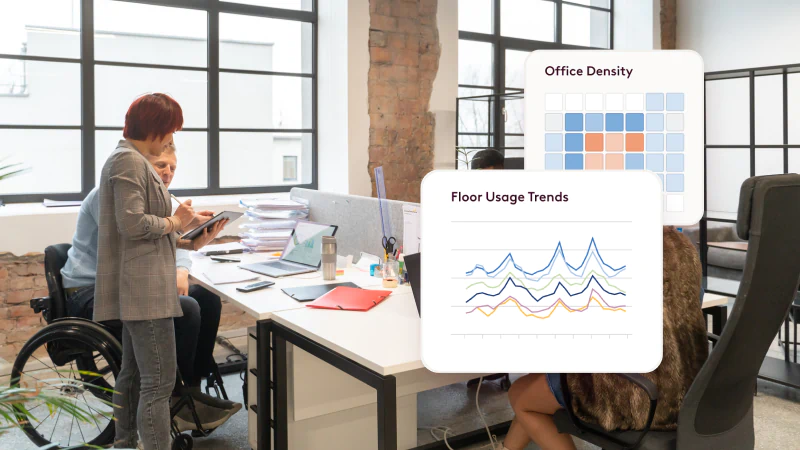Measuring Workplace Collaboration: The Ultimate Guide

The dust has settled and when it comes to the office debate, hybrid and flexible work have largely emerged as the preferred working style. So what is the next step for workplaces hoping to maximize the impact of those in-office days? For knowledge workers in particular, jobs today and in the future will continue a healthy balance of in-person time and working from home.
So what is that next step for workplaces hoping to maximize the impact of those in-office days?
When we ask our customers why they have an office, their majority of answers involve one word: Collaboration. In-person time is critical to not just planned collaboration but the spontaneous collaboration that comes with being in the same space as other people that are working towards the same goal.
This makes it even more imperative for companies to actively promote face-to-face collaboration across teams. But how? In this blog post we will review the what, why and how of measuring workplace collaboration in your offices. Let's dig in.

Why You Should Care About Measuring Workplace Collaboration
When looking at the reasons for the high levels of positivity around returning to the office, the most commonly cited reasons globally for both employers personally and employees are:
- Interacting and socializing with others (74%)
- Collaborating with others (71%)
- Ideating and brainstorming (53%)
- Developing a sense of belonging (46%)
Similar to the conversations we have at Robin with our customers, the common denominator is about seeing and working with other people in real life, not behind a computer screen. Despite what the news headlines might make you believe, it's not just employers that see the value of these interactions. In fact, according to Cisco research, almost three-quarters of professionals (72%) feel positive about going back to the office.
But does the act of collaborating in person actually make any difference to your bottom line? What about all of the recent research that suggests remote work is equally productive?
The Data: Connecting In-Person Team Collaboration and Performance
We know the benefits of providing employees with more flexibility, but what have we lost? After so much time favoring the remote side of the spectrum, how do we effectively communicate that to employees and help everyone see the value in BOTH kinds of work.
In our opinion, given the changes the office underwent during the pandemic, our ideas about working should change, too. Productivity isn't just about checking tasks off a list; it's about leveraging a range of working styles to get the best outcome (more on that here).

At Robin, we care deeply about the office because we know how much power and energy comes from people meeting face-to-face. We spend a lot of time thinking about the workplace as a whole and even more time finding new ways to help our clients get what they want out of their office space.
That’s why we built the first-ever tool to measure the power of in-person collaboration in your office. With 700 million office usage data points collected by Robin over the past 10 years, our methodology is based on actual direct office usage data, not on surveys, proxy data, or other indirect measurement techniques.
There is a treasure trove of research around the benefits of proximity of employees in a workplace environment. But when building our new Workplace Collaboration Score, we focused on the body of work around proximity and in-person interactions to drive our data modeling and scoring.
By using the science behind collaboration as our guide, office leaders can now look beyond interior design decisions, types of coffee machines, and the snack selection at an office, and instead break down the specific parameters that drive collaboration. That leaves us with one big question: How exactly do you measure collaboration? It starts with getting the right data.
(PS: Want to dig deeper into the data behind how in-person collaboration and business success are linked? Check out this blog post.)
{{collabscore-cta}}
How to Measure Collaboration with Your Office Data
Okay, you're excited to get moving on collaboration in your office. But before you can measure how well teams are doing with in-person touchpoints, you must have the right workplace processes in place. We've detailed the pieces of the collaboration puzzle above. But what day-to-day office data do we use to determine whether or not your office is actually succeeding? Here's how we break it down:
- Workplace Occupancy measures the overall density and vibrancy of the office, a key element to collaboration. The more people are present, the more collaboration takes place.
- Planned Collaboration calculates the percentage of meetings containing two or more people versus an entirely virtual meeting. Research shows that in-person meetings are more effective and lead to increased participation and creativity.
- Ad hoc Collaboration tracks the average number of employees sitting in proximity to one another. According to Northwestern University, when employees sit close to high-performing team members, their performance also increases.
By objectively measuring the collaborative environment in an office, you can compare your score to other workplaces in your industry or even other That way, executives and workplace managers can measure if their space promotes in-person collaboration effectively.
Collaborative Teams + Collaboration Tools = Innovation
By creating a more collaborative environment for your teams, you are making employee collaboration a foregone conclusion. Now that office work isn't an everyday occurrence, it's more important than ever to foster collaboration on days when in-person connections take place. Putting the thoughts and feelings aside, the empirical research here is deep and numerous research studies highlight the benefits of in-person work on collaboration and productivity in a number of settings.
Interested in learning about how you can measure collaboration in your offices? Preview how collaborative your office is using Robin's Workplace Collaboration Score and learn more about how we can use your own office data to better understand your team collaboration here!















